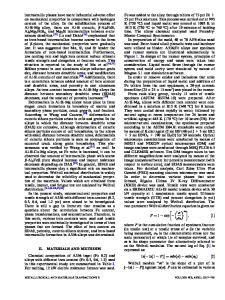Effects of Mg Content on Microstructure and Mechanical Properties of Al-14.5Si-4.5Cu Alloy
- PDF / 563,367 Bytes
- 7 Pages / 593.972 x 792 pts Page_size
- 99 Downloads / 349 Views
INTRODUCTION
THE Al-Si base alloys are the most frequently used aluminum casting alloys due to their low coefficient of thermal expansion, high fluidity, weldability, wear resistance, and corrosion resistance.[1] The Cu and Mg are typically added as alloying elements to Al-Si alloys, and appropriate heat treatment improves the mechanical properties of these Cu- and Mg-containing Al-Si alloys.[2] Hypereutectic Al-Si alloys, in which Si content exceeds 12.6 wt pct, contain many primary and eutectic silicon particles. These hard primary and eutectic silicon particles can reduce the coefficient of thermal expansion and further increase wear resistance. Hypereutectic Al-Si alloys are extensively used in the automotive, aerospace, and defense industries.[3] Iron is the most common impurity in aluminum alloys. The low solubility of iron in aluminum alloy allows for the easy combination of Al, Si, or Mg to form various iron-rich phases during solidification.[4–10] The acicular b-Al5FeSi phase is one such intermetallic compound. The tip of the acicular b-Al5FeSi phase in aluminum alloys under extension loading can easily cause stress concentration and become a crack initiator, ultimately degrading the mechanical properties of the alloys.[4–10] Reducing the amount of acicular b-Al5FeSi or changing acicular CHIH-TING WU and MENG-HSIUNG HSIEH, Graduate Students, and SHENG-LONG LEE and JING-CHIE LIN, Professors, are with the Institute of Materials Science and Engineering, Department of Mechanical Engineering, National Central University, Jhongli City, Taoyuan County 32001, Taiwan, Republic of China. Contact e-mail: [email protected] Manuscript submitted July 9, 2008. Article published online January 12, 2010 METALLURGICAL AND MATERIALS TRANSACTIONS A
b-Al5FeSi into Chinese script Al8Mg3FeSi6 or Al15Fe3Si2 or Al15(Fe,Mn)3Si2 phases in aluminum alloy can mitigate the degradation of mechanical properties.[7–10] Adding Mg to A319 Al-Si alloys converts eutectic Al2Cu and acicular b-Al5FeSi phases to Al5Cu2Mg8Si6 and Chinese script Al8Mg3FeSi6 phases, respectively, as studied by Samuel et al.[11,12] Increasing Mg content in Al-Si alloys leads to the formation of Chinese script Al8Mg3FeSi6 and Mg2Si phases. Mg-containing Al-Si-Cu alloys typically form strengthening precipitates during T6 heat treatment, improving their mechanical properties. Kang et al.[13] identified h¢ (Al2Cu) and k¢ (Al5Cu2Mg8Si6) strengthening precipitates in T6-treated Al-7Si alloys that contained various amounts of Mg (0 to 0.47 wt pct) and Cu (2.72 to 4.08 wt pct). The amounts of the h¢ and k¢ strengthening precipitates were closely correlated with the Cu and Mg content of the alloys, respectively. Since the concentration of Mg solute atoms dissolved in the Al matrix depends on the solubility limit of Mg at the solid solution temperature, the Mg content in Al-Si alloy is generally less than 0.5 wt pct.[13,14] The variable Mg content of Al-Si-Cu alloys dominates the microstructure and precipitation of strengthening phases. Although hypereutectic Al-Si alloys that
Data Loading...











